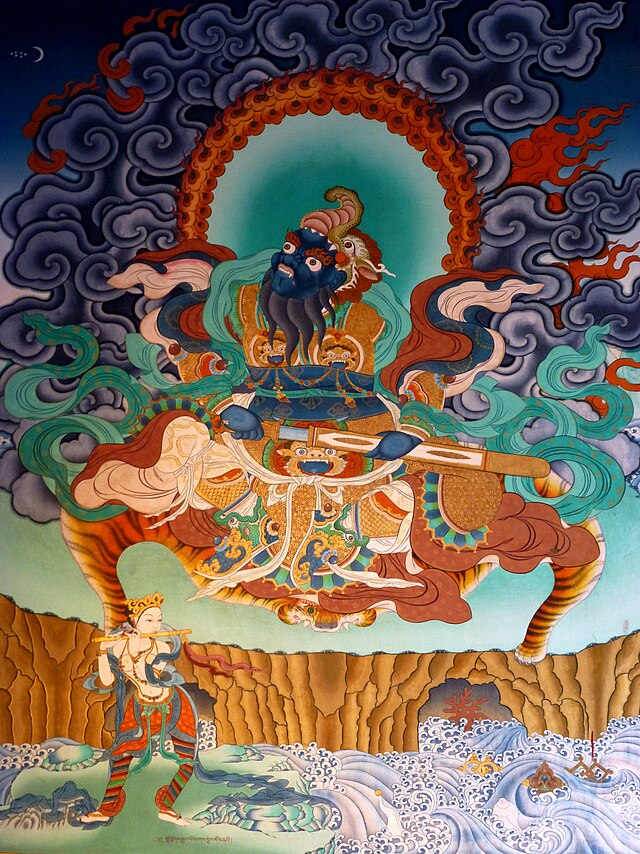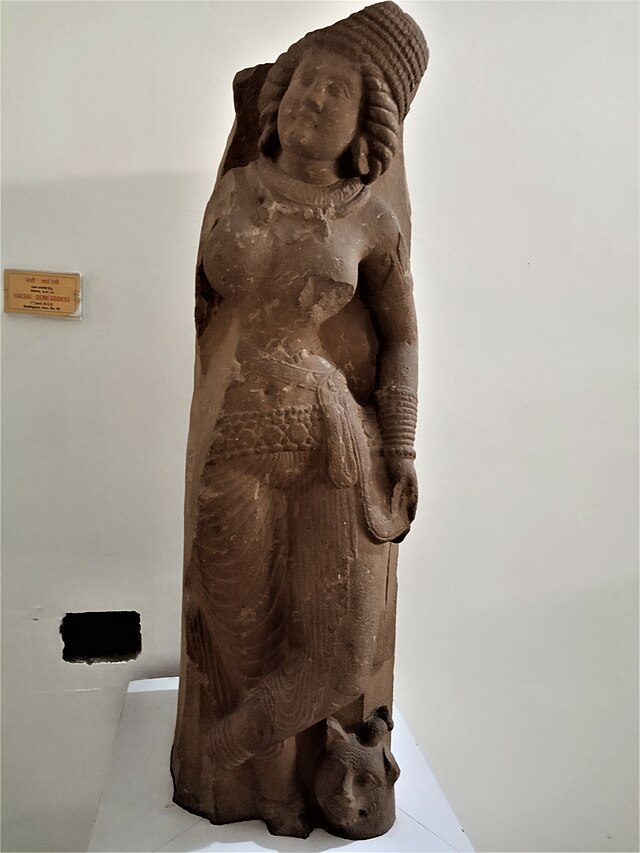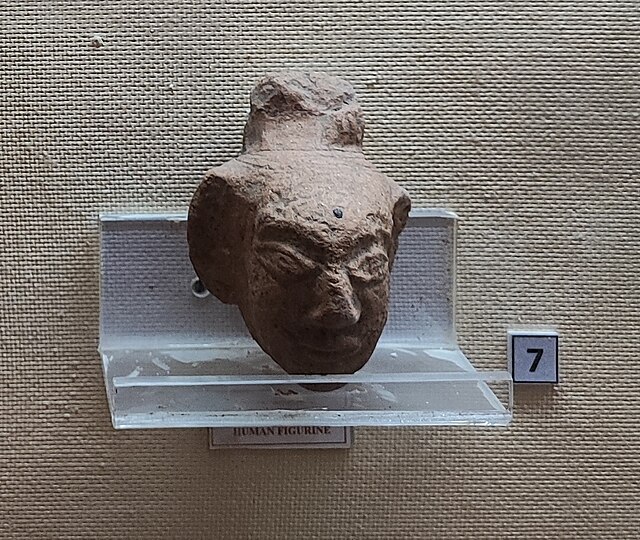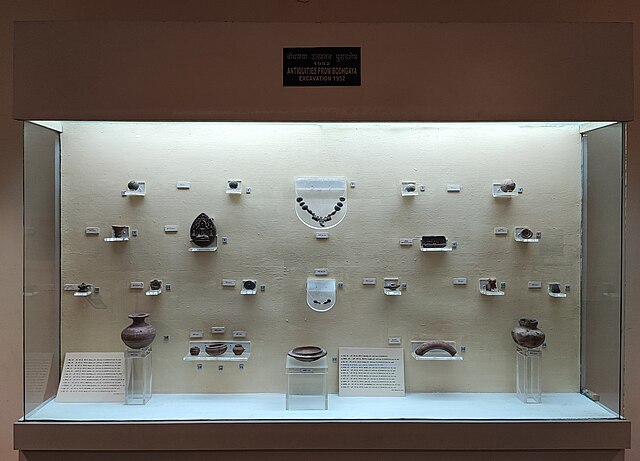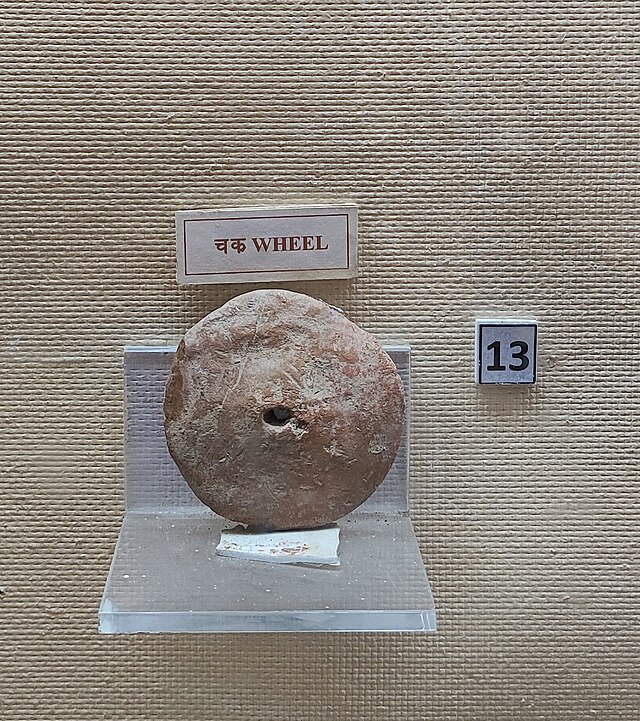Contents
Bodh Gaya, a quiet village, a peaceful religious site which is considered as the holiest pilgrimage site for buddhists.

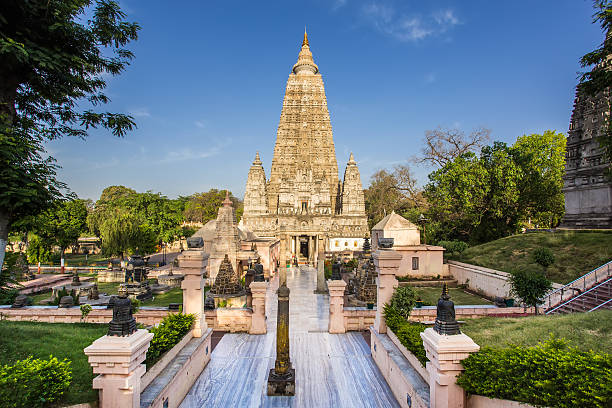
Bodh Gaya is situated near the river Niranjana in Bihar state. It is the birthplace of Buddhism as it is the place where Lord Buddha gained enlightenment over 2500 years ago and founded the way out of suffering and taught the Dhamma based on compassion, reason and universal truths shorn of ritual and superstition.
This, the holiest amongst holy places of the Buddha world, and one of the main four pilgrimage sites related to the life of Gautama Buddha is 80 km from Rajgir.
The Mahabodhi Temple Complex, which is located there, is a UNESCO World Heritage Site.
It is famous as it is the place where Gautama Buddha is said to have attained Enlightenment under what became known as the Bodhi Tree. Since antiquity, Bodh Gaya has remained the object of pilgrimage and veneration for both Hindus and Buddhists. In particular, archaeological finds including sculptures show that the site was in use by Buddhists since the Mauryan period.
Here are some places that you must see at least once in your life when you go to Bodh Gaya.
1. Mahabodhi Temple
In Bodh Gaya, the Mahabodhi Temple is a UNESCO World Heritage Site and it holds paramount significance. Mahabodhi Temple is one of the most important religious landmarks in Bodh Gaya, Bihar, India. Within this revered sanctuary, visitors have the opportunity to behold several remarkable features, including the Main Temple, The Bodhi tree, the seven sacred places, and the Bodhi Sarovar.
a. Main Temple
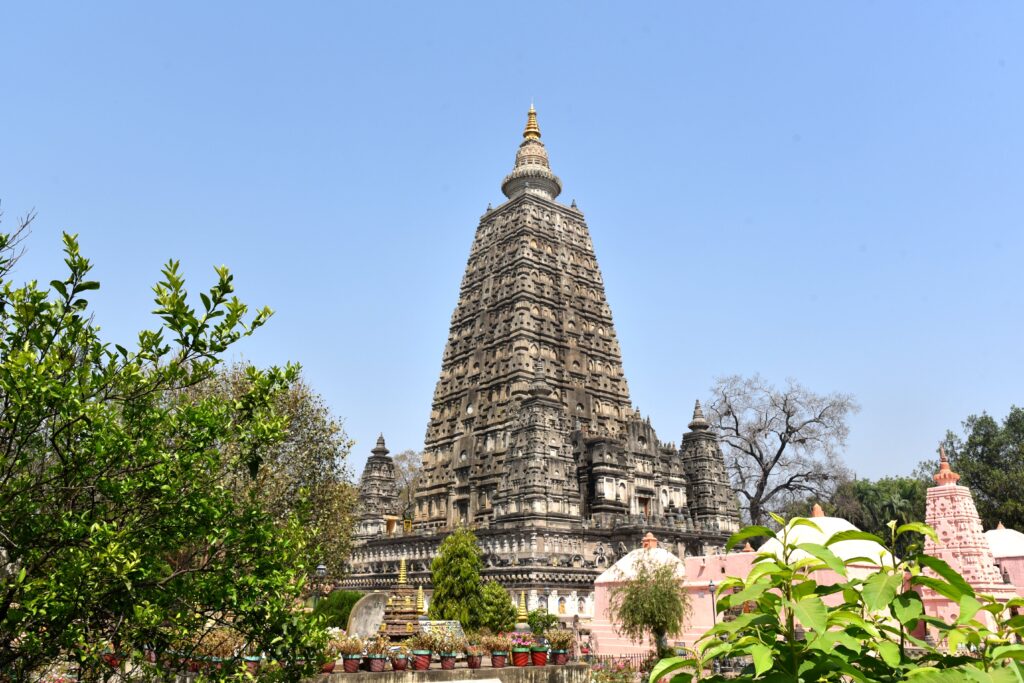
The main temple within the complex is the focal point of pilgrimage and veneration for Buddhists worldwide.
History
Ashoka visited Bodh Gaya. He is considered to be the founder of The original Mahabodhi Temple. A stone railing was put up around the perimeter of the temple in the 1st century AD., the part of which still remains.
In the 2nd century the shrine was replaced by the present Mahabodhi temple. Around 400 AD., the Chinese pilgrim Fa-hein recorded that the site contained several statues and monuments. The temple was refurbished in the Pala-Sena period (750-1200 AD), but after that it was deserted and fell into ruin. Mahabodhi was climbed bu Shaivite Hindus for a time. It was heavily restored by Sir Alexander Cunningham in the late 19th century and finally restored in 1882bby Burmese Buddhists.
In 2002 UNESCO declared it as a “World Heritage Site”. The Mahabodhi Temple is one of the earliest Buddhist temples built in brick that still survives today. The brickwork on the outside of the temple depicts scenes from Buddha life.
– Bhumi Sparsha Mudra
Inside the temple is a statue of Buddha called as Bhumi Sparsha Mudra also known as “Earth-touching gesture”. The statue is of black stone but it has been covered in gold and dressed in bright orange robes. This colossal image of seated Buddha is touching the earth with his right hand symbolizing his calling upon Mother Earth to bear witness to his attainment of enlightenment. In this posture the Buddha accomplished the supreme enlightenment.
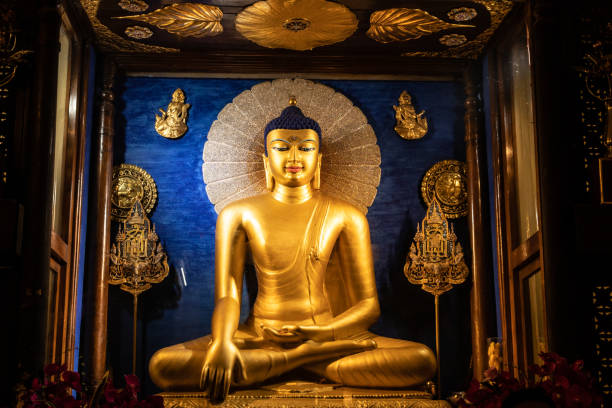
B. Bodhi tree

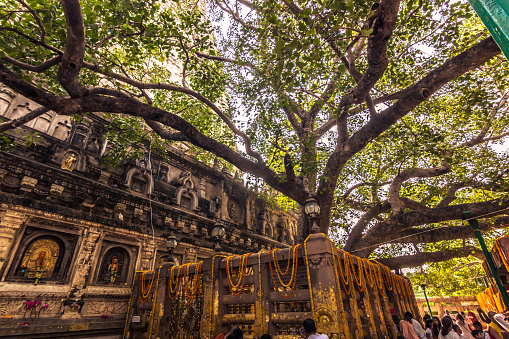

Adjacent to the temple stands the famous Bodhi tree also known as Mahabodhi Tree, Bo Tree. It is a large sacred fig tree (peepal tree) located in Bodh gaya, Bihar, India. One of the chief revered locations, is believed to be the place where Lord Buddha attained enlightenment. In religious iconography, The Bodhi Tree is recognizable by its heart-shaped leaves, which are usually prominently displayed.
The tree itself is not the actual tree but a descendent of the original Bodhi tree. It is believed to be the sapling of the original Bodhi tree, which was taken away by King Ashoka’s daughter to Sri Lanka. It is agreed that the actual tree died and another was planted there using its sapling taken from Sri Lanka.
Every time the tree was destroyed, a new tree was planted in the same place.
The tree is 80 feet high and about 120 years old. The Forest Research Institute of India has assisted in the upkeep of the tree since 2007 and the Cloning has been considered in 2008. The tree’s leaves can be bought by the pilgrims as mementos.
The Bodhi tree is located behind the main temple in Bodh Gaya. Despite the bustling surroundings, sitting beneath its branches brings a deep sense of calm and peace. Meditators find themselves embraced by a sense of tranquility.
A captivating ritual unfolds as numerous devotees patiently await the descent of a single leaf from this revered tree. Though a lot of time may pass waiting for the leaf, those with unwavering composure often choose to selflessly share their prized leaf with fellow seekers. Such acts of altruism and serenity exemplify the profound impact this ancient symbol of enlightenment holds over those who gather in its presence.
bodhi Day
Bodhi Day is celebrated on 8th December for Buddha’s enlightenment underneath the Bodhi Tree. Devotees greet each other by saying “Budu Saranai!” which means “may the peace of Buddha be yours.” Special meals are served, especially heart-shaped cookies (referencing the heart-shaped leaves of the Bodhi) and a meal of Kheer (dessert made of rice and milk rich in dry fruits) which is the Buddha’s first meal ending his six-year asceticism.
bodhi Puja
Bodhi Puja translates to “the veneration of Bodhi-tree”. It is the ritual to worship the Bodhi tree and the deity residing on it known as Rukkhadevata in Pali and Vrikshadevata in Sanskrit. It is done by giving various offerings such as food, water, milk, lamps, incense, etc. (which is later then shared with the devotees so that it does not get wasted) and chanting the verses of glory of Bodhi tree in Pali. The most common verse is:
“Ime ete mahabodhi lokanathena pujita ahampi te namassami bodhi raja namatthu te.”
c. Seven Sacred Places
There are Seven Sacred Places one must see when they visit the Mahabodhi Temple in Bodh Gaya. Gautama Buddha spent a week each for meditating after enlightenment.
These places are as follows:
1. Maha Bodhi Tree.

After having the meal of milk-rice offered by Sujata, Siddhartha was determined to not get up from his seat and continue meditating, until he attained Nirvana / Enlightenment. As he sat for meditation, Mara, the Lord of Illusion arrived at the place to distract Siddhartha. Mara sent his demons to Siddhartha with weapons to battle with. However, with the power of Siddhartha’s compassion the weapons are said to be turned into flowers. Mara lost the battle and Siddhartha became the buddha.
The buddha told Mara that all his efforts will go in vain as now, he has already won the battle and attained enlightenment. Annoyed, Mara asked for its proof, to which, Buddha touched the earth and said, Goddess of Earth, (Earth) is the proof of his enlightenment.
The buddha spent his first week meditating here after he attained Enlightenment.
2. Animisa - Lokana Stupa


Animisa also known as Animesha Lochan Chaitya is the spot in Bodh Gaya where the buddha spent his second week. Animesh Lochan Chaitya’s literal translation means open eyes. In this spot the buddha stood for one week, gazing at the Maha Bodhi Tree without blinking his eyes once. It is believed that he did this to show his gratitude for sheltering him. This spot is located
This temple located in the Mahabodhi complex is often visited for deep meditation.
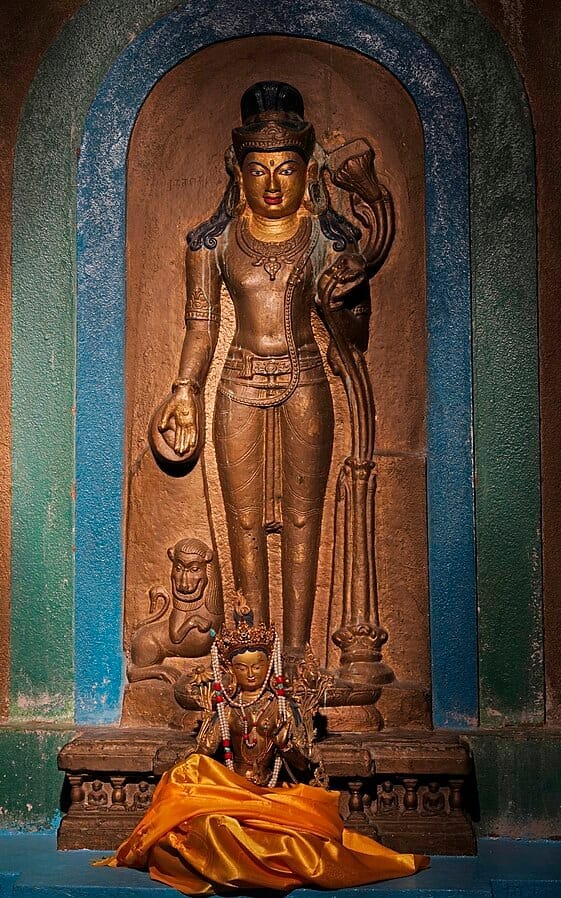
3. Chankramana Chaitya
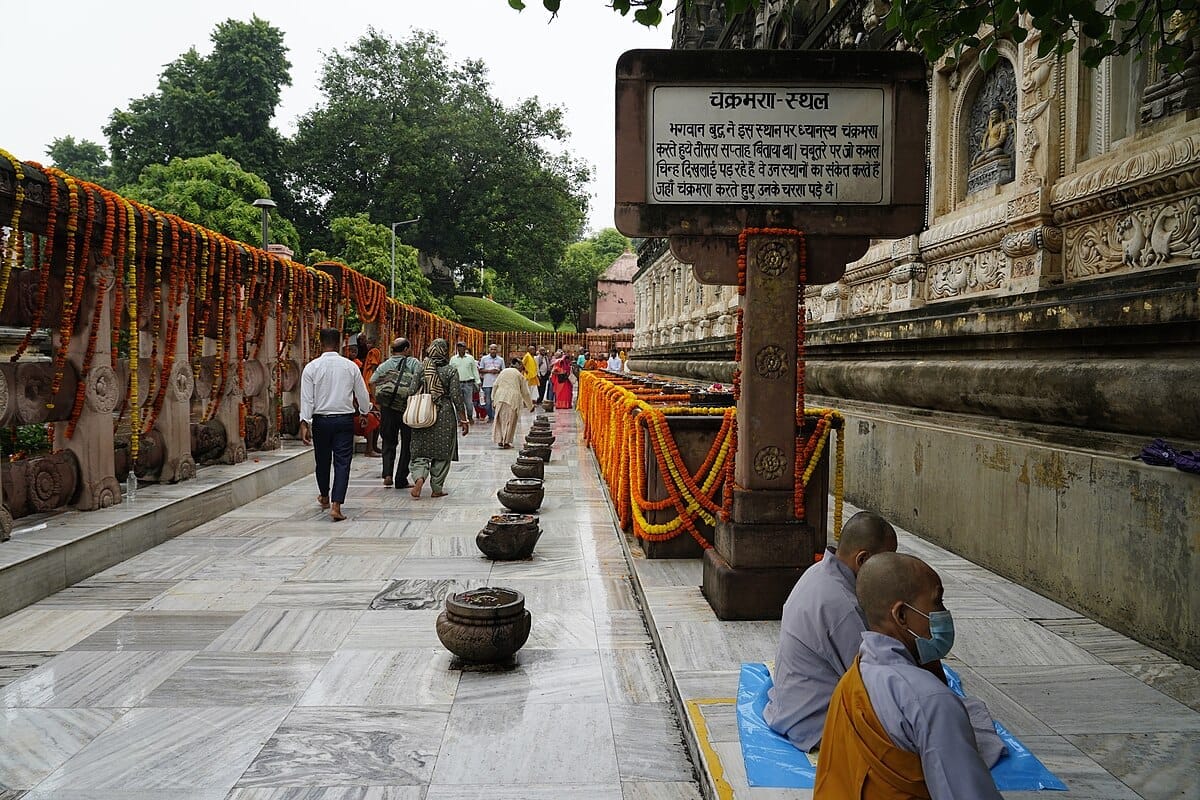

Chankramana Chaitya also known as Cankamana or Ratnacancama within the Mahabodhi temple complex located in Bodh Gaya , India is where the third week where The Buddha spent his third week. It is believed that The Buddha walked from Maha Bodhi Tree to Animisa spot back and forth for a week without stopping. It is said that a lotus plant was bloomed at wherever buddha’s feet touched the ground. Now, lotus-like raised structures are made at the same spots. This place is known as Jewel Promenade (Ratnacankama Cetiya).
4. Ratanaghara
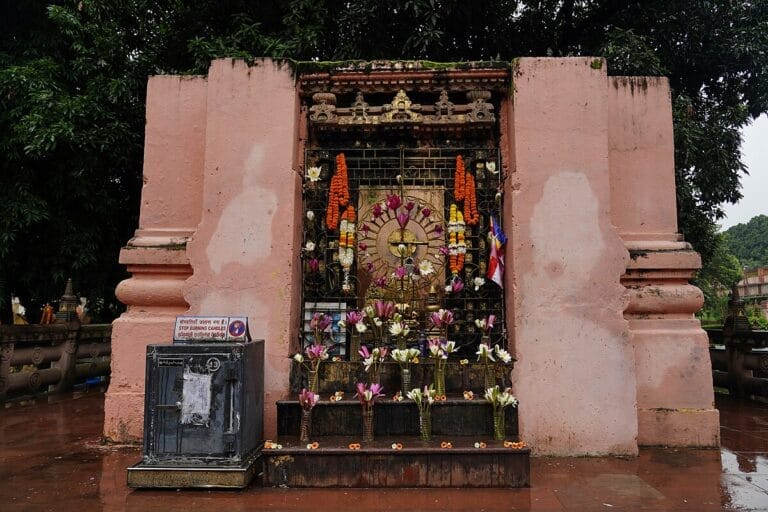
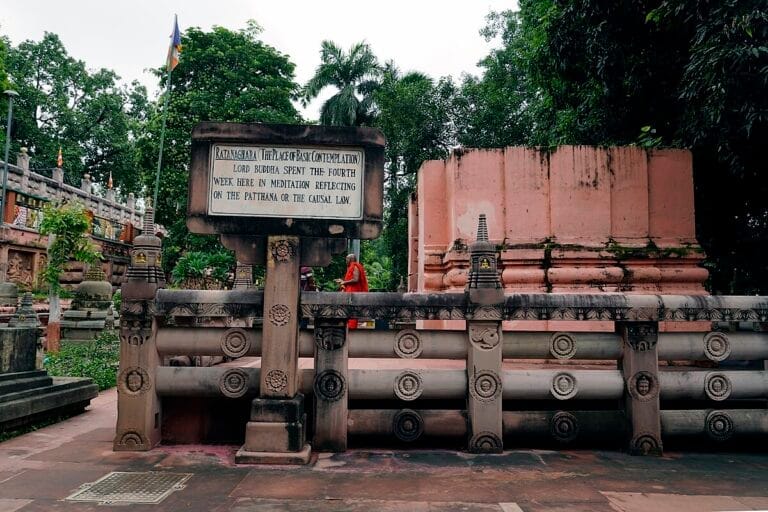
Ratanaghara spot in Mahabodhi Temple, Bodh Gaya, Bihar, India,
The buddha spent his fourth week in deep meditation. Here, The Buddha received the vision of his future mission. He thought deeply about Tripithaka ( The three baskets of teachings ) – Sutra, Vinaya and Abhidhamma. When he came to a conclusion, 5 rays of light emerged out of his body which were Blue, Yellow, Red, White, Orange. Now, These colors are used in the Buddhist flags.
5. Ajapala Nigrodha

Buddha spent his fifth week under a banyan tree. This spot is located in the Mahabodhi temple in Bodh gaya. It is believed that this tree was planted by a young shepherd boy to protect the buddha. It is believed that the Buddha defeated the three daughters of Mara known as Tanha, Arati, Raga who were sent to seduce the Buddha, but failed.
Here, Buddha gave a discourse about human equality. Caste System that divides people based on who their parents were, allowed a certain group of people to be treated miserably. Buddha explained in this discourse that An Aryan ( higher caste ) is not determined by which family one is born into but by one’s good actions.
Now, there is a stone pillar right where the tree was.
6. Mucalinda Lake / Muchalinda Lake / Bodhi Sarovar
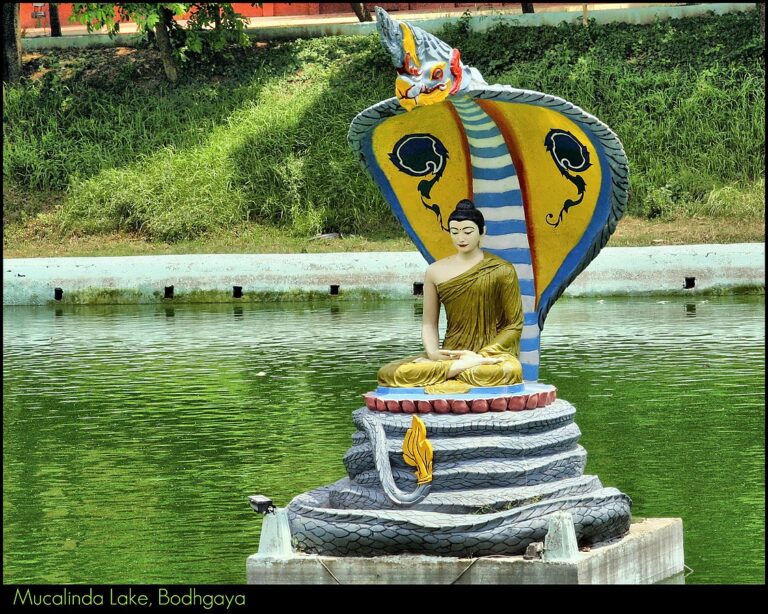

Muchalinda lake (Mucalinda Lake) / ( Bodhi Sarovar ) is situated inside Mahabodhi Temple complex in Bodh Gaya. It is situated to the west of the Bodhi Temple. It is believed to be the place where the Buddha took a bath before going to meditation.
This is one of the seven sacred places where Gautama Budhha spent a week each for meditating after enlightenment.
However, while meditating, a huge storm broke out and the buddha couldn’t meditate comfortably. Seeing this, Muchalinda, the king of serpents came to the buddha and protected him from the storm.
People often offer puffed rice to the fishes in lake.
For more information about Muchalinda lake visit
https://www.buddhist-tourism.com/countries/india/bihar/gaya/muchalinda-lake.html
7. Rajayatna
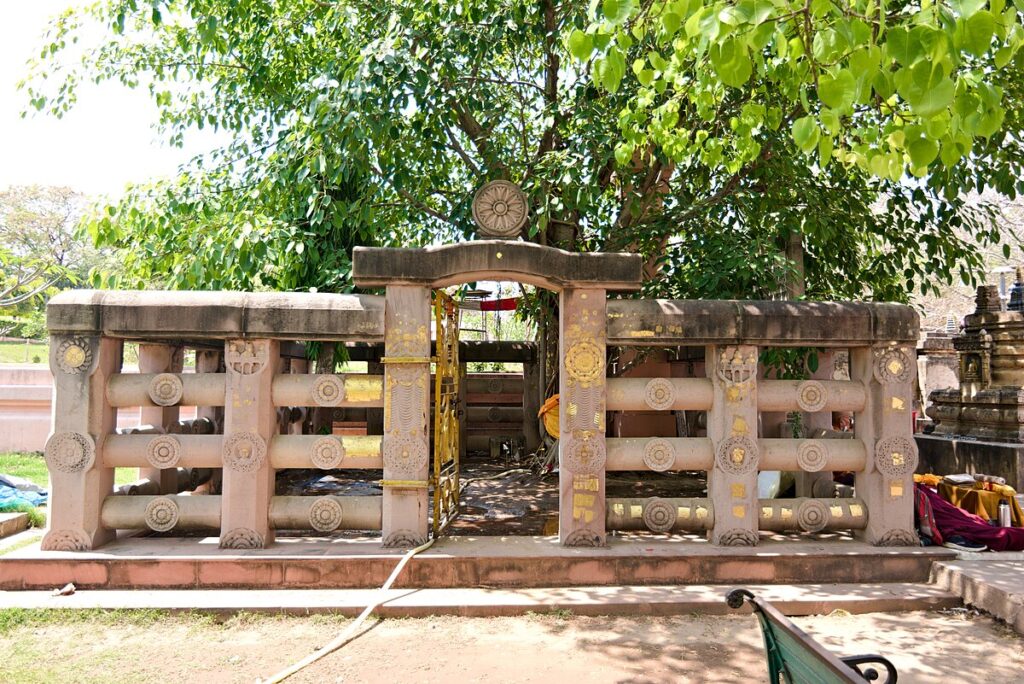
Under this tree, in Mahabodhi Temple in Bodh Gaya, Buddha spent his last of the first seven weeks meditating. It is said that two merchants known as Tapassu and Bhallika from Burma Country (Now known as Myanmar) were passing by when their carts suddenly stopped by the deities. The deities explained to them what a good opportunity is in front of them that they are in front of Gautama The Buddha. Two merchants got very happy after knowing this and offered Rice cake and Honey to the Buddha. They then took refuge in the Buddha and his teachings.
“Buddham Saranam Gacchami, Dhammam Saranam Gacchami”.
However, they could not take refuge in Sangha as it was not formed then.
Lord Buddha offered them 8 strands of his hair. Those hair relics were taken to the Burma Country by Tapassu and Bhallik, which now are inside the Shwedagon Pagoda In Burma (Myanmar).
Tapassu and Bhallika, became the first disciples of the Buddha and his teachings and the first ones to offer the Buddha food after he attained enlightenment / Nirvana
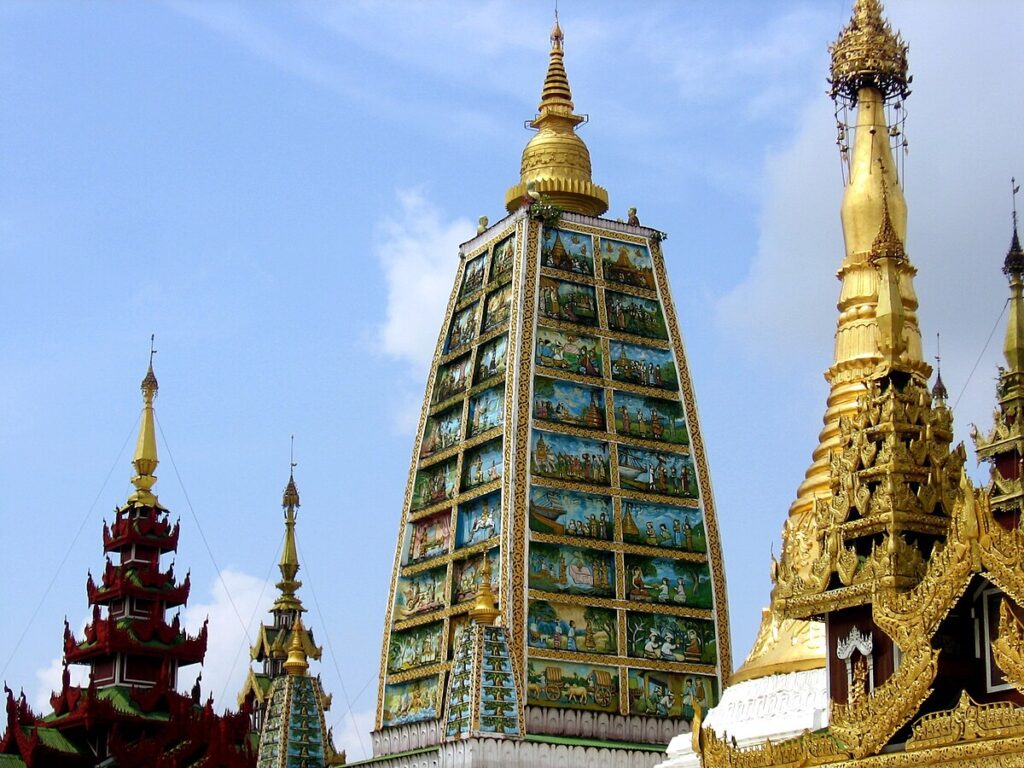

Also there is a stone platform known as Vajrasana on which the Buddha is supposed to have sat in meditation gazing east, under the Bodhi Tree while he attained enlightenment. It is considered as a sacred site and pilgrims often offer flowers and prayers here.
Here are some websites that provide more detailed information on this topic –
Here are some more details about the main temple in Bodh gaya
– Architecture
The Main temple located in Bodh Gaya follows a classic Indian architectural Style known as Nagara, characterized by its towering vimana (temple tower). It is constructed using bricks with intricate stone carvings adorning its exterior.

– Entrance
The entrance of the Main temple in Bodh Gaya is through a magnificent gateway known as Torana, which features intricate sculptures depicting scenes from Buddha’s life and various deities.
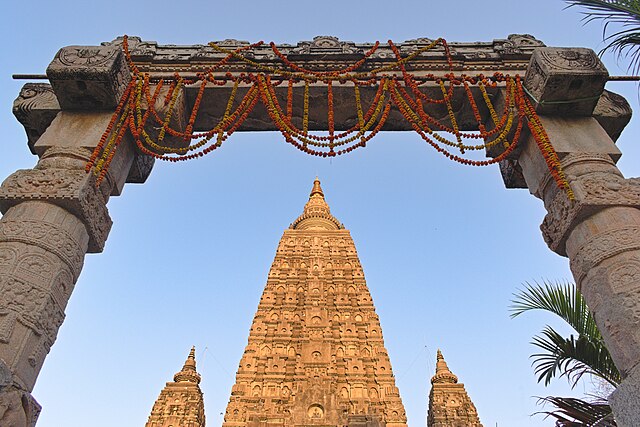
– Chattra
The temple complex features a chattra, a structure, which is large umbrella-like.It stands as one of the prominent features of Mahabodhi Temple This represents royalty and protection. This chattra was donated by King Ashoka.
– Bodhisattvas
The walls of the main temple are adorned with beautiful carvings depicting various Bodhisattvas, enlightened beings who has chosen to delay their own nirvana to help others attain enlightenment. These intricate carvings serve as a visual representation of compassion and wisdom.
– Meditation Areas
Within the Main temple complex in Bodh Gaya, there are areas designated for meditation as taught by Gautama the Buddha where visitors and meditators can sit and engage in contemplation or practice mindfulness amidst the tranquil environment.
– Offerings and Rituals
Devotees can make offerings such as flowers, incense, and candles to show reverence to Buddha within the main temple. Monks may also perform rituals like chanting or offering prayers for peace and well-being (Metta).

– Spiritual Significance
The main temple is considered a sacred space where Buddhists come to pay homage to Buddha’s enlightenment and seek spiritual inspiration. Many may believe that being in close proximity to Buddha’s presence within this sanctified space can facilitate personal transformation and inner awakening.
– Preservation
The Archaeological Survey of India (ASI) takes great care in preserving the Mahabodhi temple in Bodh Gaya and its surroundings. Regular maintenance and restoration efforts are undertaken to ensure the structural integrity and preservation of this iconic site.
The main temple within the Mahabodhi Temple Complex in Bodh Gaya stands as a testament to the rich history, profound spirituality, and timeless teachings of Buddhism. It serves as a place of pilgrimage, reflection, and reverence for those seeking enlightenment and a deeper connection with the Buddha’s profound teachings.
2. Sujata Stupa
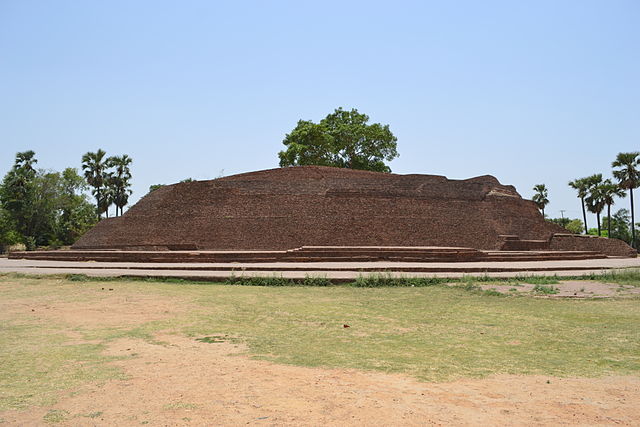
Sujata Stupa also known as Sujata Kuti Stupa is in the village of Bakraur located in the east side of Bodh Gaya in Bihar, India.
Sujata Stupa also known as Sujata Kuti Stupa is in the village of Bakraur located in the east side of Bodh Gaya in Bihar, India. It lies across the river Phalgu from the town Bodh Gaya. It is about a 20 minutes walk from Bodh Gaya to Sujata Stupa.
History
At that time, in a nearby village called Senani, lived a young, very beautiful and rich woman known as Sujata. It was her wish to get married to a man of equal rank and to have a son. She got married to the son of Anathpindaka, into a very wealthy family at that time. After waiting a long time she couldn’t have a son so she prayed to a tree god near the Niranjana River and vowed to offer the sweetest milk-rice dessert if her wish came true. After a time, her wish came true and she had a son. She was extremely happy and wanted to express her gratitude to the tree god.
Sujata had a thousand cows. She fed them Velmee (sweet creepers) so that the cows would give sweet milk. That sweet milk of a thousand cows she then fed to another 500 cows, so that these cows would give even sweeter milk, these 500 cows’ milk, she fed them to another 250 cows for sweeter milk, and so on until she fed the sweet milk to eight cows only. She did this to get the most nourishing and sweet milk to make the most delicious and sweet milk-rice dessert as an offering to the god as she promised.
Sujata then told her servant to look for the place and to clean and prepare it beforehand.
Siddharth Gautama was living his life as an ascetic monk with five others at that time. All six were determined to get enlightenment through asceticism, so they ate minimum to no food and water and continued meditating. Siddhartha went completely extreme and was said to have one grain of rice in a day or two and one drop of water in a day or two. Some days he wouldn’t have anything to eat or drink and didn’t move for days and continued meditating.
Through dirt covering his body as much as it started slipping down from his body, to storms and rain, he continued to meditate until there was nothing left in his body. It is said that the skin of his front part of the body was touching the back part of his body. Until it was almost his time for death, he punished his body to attain enlightenment.

Sujata’s servant who came to prepare the offering to a tree god saw Siddharth Gautama meditating under the tree and mistook him as the tree god. The servant returned to Sujata with a happy and excited face and told Sujata that The Banyan god is meditating under the foot of the tree, she said to Sujata, “How lucky you must be to have the god in person to accept your food, My lady!”. Sujata after hearing this news got very happy and excited and then decided to pour the milk-rice dessert in a golden bowl to offer it to the tree god.
When Sujata reached the place, she saw a handsome and golden looking man sitting under the tree and meditating. She bowed to Siddhartha and said, “Lord, I came here to offer you the sweetest milk-rice dessert. Please accept it”.
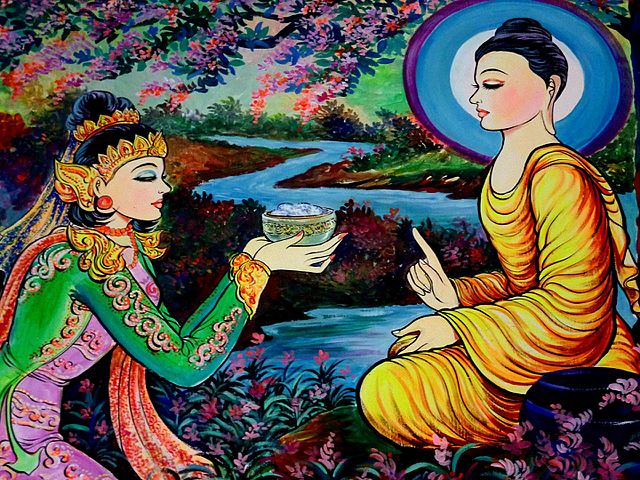
It is said that all the Buddha’s had received milk-rice dessert (Kheer) from some maiden Read More……Read Less
right before they attained enlightenment.
List of such maidens and the name of the buddha’s they offered the milk-rice to is given below.
Buddha | Maiden | |
Vipassi Buddha | Daughter of Sudassana Setthi | |
Sikhi Buddha | Daughter of Piyadasi Setthi | |
Vessabhu Buddha | Sirivaddhana | |
Kakusandha Buddha | Vajirindha | Brahmin girl of Suchirindha village |
Kongamana Buddha | Aggisoma | |
Kasyapa Buddha | Sunanda | Wife of the buddha Kasyapa |
Gautama Buddha | Sujata |
It is said that Sujata was arrogant and did not respect or obey her husband and parents. This led to troubles in the family. One day when Buddha visited the house of Anathpindaka, he heard the unusual noise at home and asked for its reason. Anathpindaka replied to the buddha saying the noise was because of Sujata who did not listen to anybody nor did she respect anyone.
The Buddha then called Sujata and talked to her very softly and kindly that there are seven types of wives a man might have and asked Sujata which type of wife she is. Sujata asked the Buddha about all the seven types.
The Buddha said, the first type of wife is undesirable and bad. She always makes trouble, is short-tempered, wicked, pitiless and unfaithful to her husband.
The second type of wife wastes all the hard earned money of her husband.
The third type of wife is very selfish, only thinks about herself, is lazy, has no compassion, she just gossips and scolds her husband.
The fourth type of wife is good and praiseworthy.
The fifth type of wife is like a mother. She always cares for her husband and others as if they are her own child. She is kind and compassionate and careful with the money.
The fifth type of wife is like a sister. She respects her husband as a sister would respect her own elder brother. She is obedient and humble.
The sixth type of wife is like a friend to her husband. She treats her husband as if he is a friend and gets happy when she sees her husband as a friend would get happy after seeing their friend after some time.
The last type of wife is like the maid. She is obedient, calm, and shows no sign of anger. She stays calm even when her husband uses hurtful or harsh words towards her. She obeys all of her husband’s wishes as if she is the maid of the house.
After describing all the types of wives a man can have, Buddha asks Sujata, “So tell me Sujata, which type of a wife are you? And which type of wife do you want to be?”
Sujata realizes about her bad attitude and gets ashamed about her past behavior. She changed her behavior and became a calm and understanding wife. She became her husband’s helper. Sujata and her husband both worked together towards enlightenment.
It is said that all the Buddha’s had received milk-rice dessert (Kheer) from some maiden Read More……Read Less
right before they attained enlightenment.
List of such maidens and the name of the buddha’s they offered the milk-rice to is given below.
Daughter of Sudassana Setthi offered Vipassi Buddha kheer.
Daughter of Piyadasi Setthi offered kheer to Sikhi Buddha.
Sirivaddhana offered Kheer to Vessabhu Buddha.
Vajirindha, Brahmin girl of Suchirindha village offered kheer to Kakusandha Buddha.
Aggisoma offered kheer to Kongamana Buddha.
Kasyapa Buddha was offered kheer by his wife Sunanda.
Gautama Buddha Was offered kheer by Sujata.
It is said that Sujata was arrogant and did not respect or obey her husband and parents. This led to troubles in the family. One day when Buddha visited the house of Anathpindaka, he heard the unusual noise at home and asked for its reason. Anathpindaka replied to the buddha saying the noise was because of Sujata who did not listen to anybody nor did she respect anyone. The Buddha then called Sujata and talked to her very softly and kindly that there are seven types of wives a man might have and asked Sujata which type of wife she is. Sujata asked the Buddha about all the seven types.
The Buddha said, the first type of wife is undesirable and bad. She always makes trouble, is short-tempered, wicked, pitiless and unfaithful to her husband.
The second type of wife wastes all the hard earned money of her husband.
The third type of wife is very selfish, only thinks about herself, is lazy, has no compassion, she just gossips and scolds her husband.
The fourth type of wife is good and praiseworthy.
The fifth type of wife is like a mother. She always cares for her husband and others as if they are her own child. She is kind and compassionate and careful with the money.
The fifth type of wife is like a sister. She respects her husband as a sister would respect her own elder brother. She is obedient and humble.
The sixth type of wife is like a friend to her husband. She treats her husband as if he is a friend and gets happy when she sees her husband as a friend would get happy after seeing their friend after some time.
The last type of wife is like the maid. She is obedient, calm, and shows no sign of anger. She stays calm even when her husband uses hurtful or harsh words towards her. She obeys all of her husband’s wishes as if she is the maid of the house.
After describing all the types of wives a man can have, Buddha asks Sujata, “So tell me Sujata, which type of a wife are you? And which type of wife do you want to be?”
Sujata realizes about her bad attitude and gets ashamed about her past behavior. She changed her behavior and became a calm and understanding wife. She became her husband’s helper. Sujata and her husband both worked together towards enlightenment.
3. The great Buddha Statue
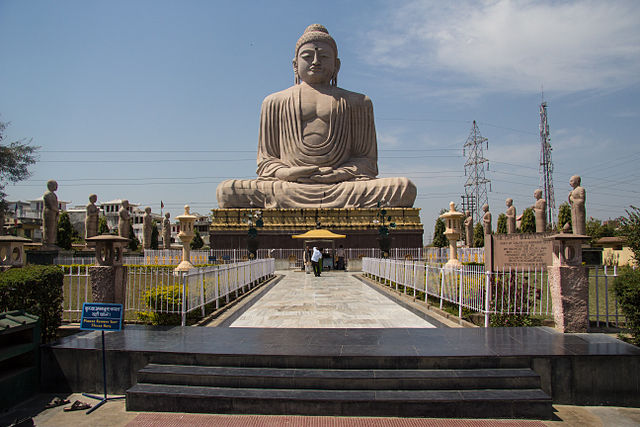
The great Buddha Statue is one of the important stops for buddhist pilgrimage in Bodh Gaya, Bihar, India. It is less than 1 km away from Bodh Gaya old town center. It is located in a garden at the end of Temple Street.The width of the statue is around 60 feet (18 m).
The statue represents Buddha sitting in a meditative pose (dhyan mudra) peacefully on a lotus in the open air. It is 80 feet (24 m) tall and said to be one of the tallest statues in India. It is constructed with sandstone and red granite. It took seven years to complete this statue. It was the largest statue in india at the time it was consecrated by the Dalai Lama on 18 November 1989.
It is surrounded by small sculptures of Buddha’s ten most important disciples.
Those ten important disciples of Buddha are – Read More……Read Less If you want to know more about the ten most important disciples of the Buddha then check out our another blog. Ten Most Important Disciples Of Buddha.
Avoid visiting this place in the afternoon in summer because the marble floor becomes very hot and you will be unable to walk barefoot in this place.
Time – 7 am to 12 pm, 2 pm to 5:30 pm
Entry – free
4. Thai Monastery
Wat Thai Temple
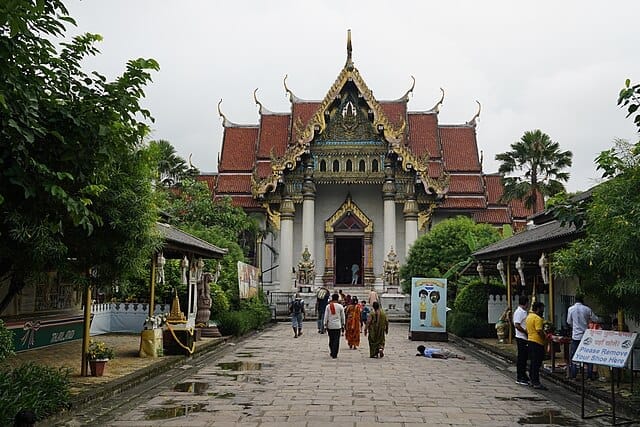

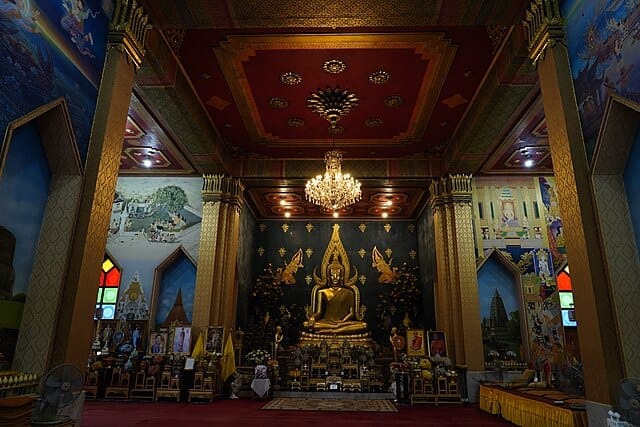
This monastery is 700 m away from Main Bodhi Temple. It is situated in Bodh Gaya, Bihar, India near Maya Sarovar. It is one of the most visited places in Bodh Gaya. It was established by the Thai Government on the request of the former Prime Minister Jawaharlal Nehru in 1956 to strengthen the relationship between the two countries.
This monastery stands out the most amongst all the other international monasteries in Bodh Gaya because of its Golden roof and stunning architecture.It is in a small park. It exhibits colors of Thai culture and tradition. This temple has a 25-m-high bronze statue of Buddha. People who visited there say that This Thai monastery is very peaceful and worth visiting. It is said to be very hygienic and a calm place to meditate. The ground creates a quiet and calm atmosphere. Good resting place near the main temple.
Meditation classes are held in the morning and evening in this monastery. More than a hundred people practice meditation as taught by Gautama the Buddha here.
There is also a guest house on the premises to stay.
Time – 6 am to 7 pm
The entry is free.
For more information about the monastery visit the below link –
https://www.trawell.in/bihar/bodhgaya/wat-thai-buddhagaya-thai-monastery
5. Tibetan Monastery
Shechen Tennyi Dargyeling
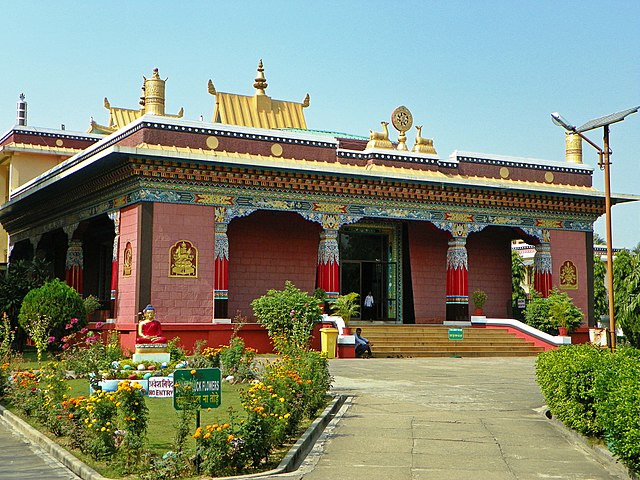
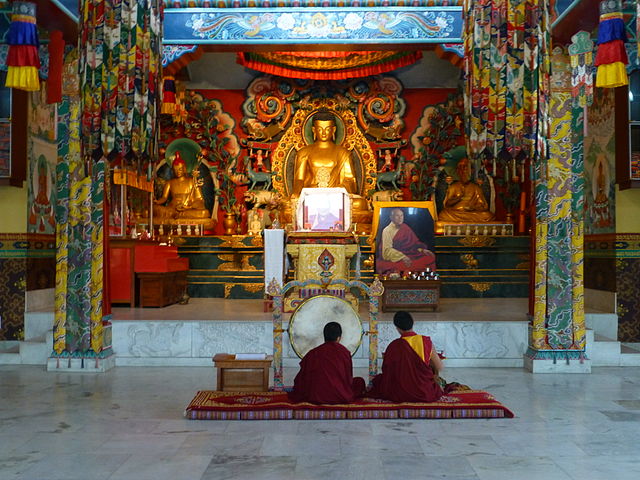
Shechen Tennyi Dargyeling monastery is a Tibetan monastery which is located in Bodh Gaya, Bihar, India. It is a few minutes walk away from the Great Buddha Statue.
Dilgo Khyentse Rinpoche had a wish to construct a monastery for the Nyingma School in Bodh Gaya. This project was accomplished by Shechen Rabjam Rinpoche and some generous donors and volunteers. The official opening ceremony was performed by the Dalai Lama.
The main temple is made of red stone and it has the design and shape of a golden roof.
There are three large statues made by Bhutanese artists. These three statues are of the Lord Buddha in the center and on either side are the statues of Guru Padmasambhava and Dilgo Khyentse Rinpoche.
Tsering Arts School’s teachers and students have done frescos (a painting done rapidly in watercolor on wet plaster on a wall or ceiling.) on buddha’s life in the main temple in this complex.
In another building, residence is provided for about 30-50 monks. There is also a reading room library stocked with Western language books.
In the third building there is the Shechen Institute, the International Center for Nyingma Buddhist Studies founded by Shechen Rabjam Rinpoche and inaugurated by the Queen Mother of Bhutan. This institute has nineteen double rooms which are very comfortable. It also has a large dining hall.
Shechen Institute offers a ten day study and practice program of Buddhist philosophy in depth for students all over the world. This study is offered once a year.
Shechen Institute is planning to provide a clinic on wheels dedicated to bringing free and professional medical assistance to the people of neighboring villages as Bodh Gaya located in Bihar is one of the poorest regions in India.
More detailed information on this topic is given in this following website –https://www.shambhala.com/snowlion_articles/shechen-monastery-india/
Time – 7 am to 6 pm.
The entry is free.
6. Archaeological Museum

The Archaeological Museum is located in Bodh Gaya, Bihar, India. It is loathed in close proximity of the Main Maha Bodhi Temple.
There are sculptures, artifacts and antiques which includes objects and coins from Mauryan, Gupta and Mughal period of Buddhism and Hinduism from 2nd century BC to 11th century CE.
This museum of Bodh Gaya was inaugurated by the Dalai Lama on 27th December 1956.
Images of Buddha, Maitreya, Manjusri, Avalokitesvara, Tara, Jambhala, Vishnu, Ganesha, Uma Maheshwara, Kamadeva, Saptamatrika, Navagrah, Dasavatara, Dikpala, Nairotma are showcased. Storytelling stones carved in sandstone and granite from 2nd century BCE from Sunga period and 6th-7th century CE which belongs to Maha Bodhi Temple is also there.
To know more about this topic visit the following links –
https://en.wikipedia.org/wiki/Archaeological_Museum_of_Bodhgaya
https://asi.nic.in/museum-bodhgaya/
Time – 10 am to 5 pm (Closed on Fridays)
Entry – 10 rupees per person. (Free for children up to 15 years of age)
want to see these places by your own eyes? Want to walk on the path the buddha walked? want to meditate in the places the buddha has meditated? want to go on a tour to Bodh Gaya and other places nearby?
Check out our tours. we have three different plans. choose the most suitable plan for you.
The best time to plan a trip to Bodh Gaya

The best time to plan a visit to Bodh Gaya is during the winter season. Exploring the multiple sites in a single day during the summer months can be exhausting, with temperatures soaring as high as 40 degrees celsius during the day and and 26 degrees celsius at night. For foreign visitors unaccustomed to such intense heat, it is advisable to schedule their trip during the winter months
During winter, Bodh Gaya experiences more moderate temperatures ranging from 75°F (24°C) during the day to a cooler low of 49°F (9°C) at night. To ensure a comfortable and enjoyable experience, it is essential to pack appropriate clothing suitable for the prevailing weather conditions. This will enable visitors to fully appreciate and explore the various sites without and discomfort. By planning your trip during the winter season and dressing accordingly, you can make the most of your visit to Bodh Gaya and enjoy its significant landmarks to their fullest extent.
While it is true that some foreigners may enjoy visiting Bodh Gaya during the summer season, it is important to note that India’s tropical climate can result in extremely high temperatures, particularly during the months of April, May and October. To ensure a more comfortable experience, it is advisable to plan your visit during periods when summer is just beginning or when the rainy season has recently passed. For example, in February, temperatures range around 27°C during the day and 12°C at night.
In March, temperatures are approximately 22°C during the day and 16°C at night. These months offer milder weather conditions compared to the peak of summer.
Alternatively, another favorable time to visit Bodh Gaya is in October or November when the monsoon season has subsided. During October, temperatures reach around 32°C during the day and 21°C at night. In November, temperatures can go as high as 29°C in the day and dip to around 14°C at night.
By choosing these periods for your visit to Bodh Gaya you can enjoy more pleasant weather conditions that will enhance your overall experience without being subject to extreme heat or humidity.




